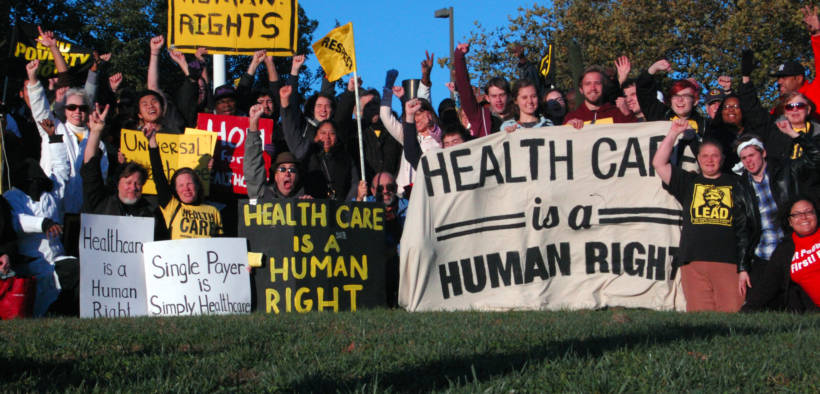Record 25% Of Americans Put Off Medical Treatment Because Of High Costs

An estimated 500,000 Americans every year are driven into bankruptcy due to medical bills or missed work from illness.
A report from Gallup published earlier this month demonstrates the consequences of the United States’ exceptionally high health care costs, with a record 25% of Americans telling the polling outfit that they or a family member had deferred treatment for a serious medical condition because they couldn’t afford care.
“A record 25% of Americans say they or a family member put off treatment for a serious medical condition in the past year because of the cost, up from 19% a year ago and the highest in Gallup’s trend,” wrote Gallup. “Another 8% said they or a family member put off treatment for a less serious condition, bringing the total percentage of households delaying care due to costs to 33%, tying the high from 2014.”
Journalist Bob Hennelly argues that America’s exorbitant health care costs reveal the media’s failure to accurately cover the country’s economic situation. Despite praise heaped on the record-breaking stock market and low unemployment rate, almost half of Americans work low wage jobs as basic living costs like health care, education, and housing continue to rise.
“The most underreported of all economic stories is that the anemic wage gains posted by American workers have been entirely devoured, and then some, by the Trump era’s spike in health care premiums and drug costs,” Hennelly wrote with Salon last week.
Beyond the Gallup poll, Hennelly cites a 2018 study by the American Journal of Public Health and a study by the Kaiser Foundation as evidence that the U.S. current health care system is one of the driving forces behind the nation’s growing inequality. According to the American Journal of Public Health, medical bills or missed work from illness drive 500,000 Americans into bankruptcy every year.
“The average premium for family coverage has increased 22 percent over the last five years and 54 percent over the last ten years, significantly more than either workers’ wages or inflation,” according to an annual survey by the Kaiser Foundation of employer-sponsored health coverage.
Prices In The U.S. Versus Other Countries
Gallup’s recent finding that 25% of Americans put off serious medical procedures because of high costs was reinforced by a New York Times analysis on Friday finding “a large divergence between the United States and everyone else” on the cost of common medical services.
“For a typical angioplasty, a procedure that opens a blocked blood vessel to the heart, the average U.S. price is $32,200, compared with $6,400 in the Netherlands, or $7,400 in Switzerland, the survey finds,” wrote the Times’ Margot Sanger-Katz, citing a report from the International Federation of Health Plans, a group representing the C.E.O.s of health insurers worldwide.
“A typical M.R.I. scan costs $1,420 in the United States, but around $450 in Britain. An injection of Herceptin, an important breast cancer treatment, costs $211 in the United States, compared with $44 in South Africa,” Sanger-Katz continued. “These examples aren’t outliers.”
At around 18% of GDP, American per capita health care expenditures are more than twice the average of the 35 advanced countries in the Organization for Economic Cooperation and Development (OECD). Yet despite outspending these countries, the U.S. “has the lowest life expectancy, the greatest incidence of chronic illnesses, and the highest infant, child, and maternal mortality rates” in the OECD, according to economist Robert H. Frank.
“It is staggering how much the United States is more expensive,” John Hargraves, the director of data strategy at the Health Care Cost Institute, a group that aggregates claims data from several large American insurance companies and provided the U.S. data to the study, told the Times.
A Harvard study last year found that “prices of labor and goods, including pharmaceuticals and devices, and administrative costs appeared to be the main drivers of the differences in spending,” as the main reasons making the U.S. healthcare system so much more expensive than other rich nations. Additionally, a JAMA study from October found that around 25% of American healthcare spending is wasteful, with the largest single source of waste being administrative costs, totaling $266 billion a year.
“No developed country other than the United States relies on largely unregulated insurance companies for the provision of health care,” Economist Robert H. Frank told Evonomics last year, citing America’s weakly regulated profit-driven health care model as the reason for higher costs and worse outcomes.
The Times notes that exorbitant prices hurt the broader economy, as the “overall upward creep of prices has also led insurance premiums to rise, taking a bite out of tax revenue, wages and corporate profits.”
But while Gallup found that these high prices have forced a quarter of the American population to defer care for serious medical conditions, “they also finance a robust and politically powerful health care industry, which means lowering prices will always be hard,” noted the Times.
Indeed, the powerful hospital, pharmaceutical, and health insurance industries have used their vast resources to fight against significant changes to the healthcare system, giving extensive funds to the corporate media, lawmakers, and lobbyists who oppose structural reform.







